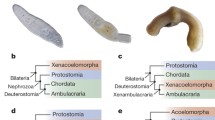Abstract
Using nucleotide sequences of 5S ribosomal RNAs from 2 hydrozoan jellyfishes, 3 scyphozoan jellyfishes and 2 sea anemones, a phylogenetic tree of Cnidaria has been constructed to elucidate the evolutionary relationships of radial and bilateral symmetries. The 3 classes of Cnidaria examined herein belong to one branch, which does not include other metazoan phyla such as the Platyhelminthes. The Hydrozoa (having radial symmetry without septa) and the Scyphozoa (having radial symmetry with septa) are more closely related to each other than to the Anthozoa (having bilateral symmetry with septa). In classical taxonomy, multicellular animals are considered to have evolved through organisms with radial symmetry (e.g., Cnidaria) to bilateral symmetry. Our results, however, indicate that the emergence of the Bilateria was earlier than that of the Radiata, suggesting (in opposition to Haeckel's view) that the radial symmetry of Cnidaria is an evolutionary dead end.
Similar content being viewed by others
References
Had\>zi, J., 1963. The evolution of Metazoa. Pergamon, N.Y., 499 pp.
Hanson, E. D., 1977. The origin and early evolution of animals. Wesleyan Univ. Press, Middletown, 670 pp.
Hendriks, L., R. De Baere, A. Vandenberghe & R. De Wachter, 1987. The nucleotide sequence of the 5S ribosomal RNA of Actinia equina and Sepia officinalis. Nucl. Acids Res. 15: 2773.
Hori, H. & S. Osawa, 1987. Origins and evolution of organisms as deduced from 5S ribosomal RNA. Mol. Biol. Evol. 4: 445–472.
Hori, H., T. Ohama, T. Kumazaki & S. Osawa, 1982. Nucleotide sequences of 5S rRNAs from four jellyfishes. Nucl. Acids Res. 10: 7405–7408.
Hori, H., A. Muto, S. Osawa, M. Takai, K.-Y. Lue & M. Kawakatsu, 1988. Evolution of Turbellaria as deduced from 5S ribosomal RNA sequences. Prog. Zool. 36: 163–167.
Jukes, T. H. & C. R. Cantor, 1969. Evolution of protein molecules. In H. N. Munro (ed.), Mammalian Protein Metabolism III. Academic Press, N.Y.: 21–132.
Kumazaki, T., H. Hori & S. Osawa, 1982. The nucleotide sequence of 5S ribosomal RNA from a sea-anemone, Anthopleura japonica. FEBS Lett. 146: 307–310.
Walker, W. F. & D. F. Doolittle, 1983. 5S rRNA sequences from four marine invertebrates and implications for base pairing models of metazoan sequences. Nucl. Acids Res. 11: 5159–5164.
Author information
Authors and Affiliations
Rights and permissions
About this article
Cite this article
Hori, H., Satow, Y. Dead-end evolution of the Cnidaria as deduced from 5S ribosomal RNA sequences. Hydrobiologia 216, 505–508 (1991). https://doi.org/10.1007/BF00026505
Issue Date:
DOI: https://doi.org/10.1007/BF00026505




